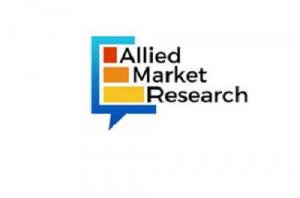Rising Demand Pushes Battery Scrap Market Toward $83.7 Billion by 2032
Recycling battery scrap is not just waste management—it's a strategic raw-material pipeline that reduces risk, cost, & carbon footprint of battery supply chains
WILMINGTON, DE, UNITED STATES, September 3, 2025 /EINPresswire.com/ -- According to a new report published by Allied Market Research, titled, “Battery Scrap Market by Product type (Lead Acid, Lithium Ion, Others), by Source (Electric Vehicles, Consumer Electronics, Power Tools, Others), by End-use (Material Extraction, Reuse, Disposal, Others): Global Opportunity Analysis and Industry Forecast, 2022 - 2032" The global battery scrap market was valued at $35.2 billion in 2022, and is projected to reach $83.7 billion by 2032, growing at a CAGR of 9.1% from 2023 to 2032.The battery scrap market collects, sorts, and processes end-of-life and manufacturing-waste batteries (lead-acid, lithium-ion, nickel-metal hydride, etc.) to recover valuable materials—lead, lithium, cobalt, copper, nickel, and rare earths—and to safely dispose of hazardous components. Driven by rising electric-vehicle (EV) deployment, expanding consumer electronics use, and stricter waste-management regulations, the market is evolving from ad-hoc salvage toward organized, industrial-scale recycling and material-recovery value chains that reduce raw-material dependency and lower lifecycle emissions.
𝗗𝗼𝘄𝗻𝗹𝗼𝗮𝗱 𝗣𝗗𝗙 𝗕𝗿𝗼𝗰𝗵𝘂𝗿𝗲: https://www.alliedmarketresearch.com/request-sample/A13818
𝗠𝗮𝗿𝗸𝗲𝘁 𝗗𝘆𝗻𝗮𝗺𝗶𝗰𝘀
The primary growth driver is the rapid increase in EVs and battery-powered devices: as battery volumes in use climb, volumes of end-of-life (EOL) batteries available for scrap grow predictably, creating feedstock for recycling facilities and downstream material-recovery services. This steady inflow is encouraging investments in collection networks, reverse-logistics, and specialized recycling capacity.
Technology and process improvements - particularly hydrometallurgical and direct-recycling routes are raising recovery rates for critical metals (lithium, cobalt, nickel) and improving economics compared with traditional pyrometallurgy. Better recovery yields and lower energy intensity increase the commercial attractiveness of recycling and support circular-economy pledges from OEMs and governments.
Regulatory pressure and producer-responsibility frameworks (extended producer responsibility, landfill bans for batteries, and recycling targets) are forcing OEMs and recyclers to formalize take-back schemes and reporting, improving traceability of material flows but also adding compliance costs. Stronger regulation increases collection rates and makes upstream design-for-recycling more valuable, but compliance complexity can raise barriers for smaller players.
Supply-chain factors and raw-material price volatility create compelling economics for recovered materials: when prices for lithium, cobalt, or nickel spike, recovered feedstock can meaningfully lower input costs for cell makers. Conversely, low commodity prices temporarily compress recyclers margins, so many operators hedge by signing offtake agreements or integrating downstream refining to capture more value.
Challenges remain around safe collection, transportation, and standardized testing for state-of-health (SOH) of EOL cells, alongside environmental and safety risks (thermal runaway, acid/alkaline leaks). Building trusted grading systems, scalable second-life markets for partially degraded packs, and regulated treatment infrastructure are critical to unlocking full value and minimizing environmental harm.
𝗦𝗻𝗮𝗴 𝗗𝗶𝘀𝗰𝗼𝘂𝗻𝘁: https://www.alliedmarketresearch.com/checkout-final/A13818
𝗦𝗲𝗴𝗺𝗲𝗻𝘁 𝗢𝘃𝗲𝗿𝘃𝗶𝗲𝘄
The battery scrap market analysis can be segmented by battery chemistry (lead-acid, lithium-ion, NiMH, alkaline), feedstock source (automotive EOL, industrial/ESS, consumer electronics, manufacturing scrap), and processing route (pyrometallurgical, hydrometallurgical, direct recycling, mechanical separation). Each segment has distinct economics and regulatory drivers: lead-acid is a mature, highly recycled stream; lithium-ion is fast-growing with higher technical complexity and material value; manufacturing scrap is often the highest-margin, easiest-to-process feedstock.
𝗥𝗲𝗴𝗶𝗼𝗻𝗮𝗹 𝗔𝗻𝗮𝗹𝘆𝘀𝗶𝘀
Asia-Pacific dominates current volumes due to large automotive and electronics manufacturing bases and substantial EV adoption—China, Japan, and South Korea lead in both cell production and early-stage recycling infrastructure. Policy focus on resource security and aggressive industrial investments is accelerating capacity expansion and technology deployment across the region.
Europe and North America are strengthening markets driven by strict recycling targets, incentives for domestic processing, and the rise of local battery gigafactories. Europe’s regulatory framework and producer-responsibility rules are fostering centralized collection and certified recycling schemes, while North America emphasizes domestic supply-chain resilience and investment in higher-recovery technologies.
𝗙𝗼𝗿 𝗣𝘂𝗿𝗰𝗵𝗮𝘀𝗲 𝗜𝗻𝗾𝘂𝗶𝗿𝘆:
https://www.alliedmarketresearch.com/purchase-enquiry/A13818
𝗖𝗼𝗺𝗽𝗲𝘁𝗶𝘁𝗶𝘃𝗲 𝗔𝗻𝗮𝗹𝘆𝘀𝗶𝘀
The competitive landscape includes specialized recyclers, integrated metal-refiners, new-technology startups, and OEM-backed ventures. Established recyclers focus on scale, compliance, and networked collection, while startups often differentiate with novel hydrometallurgical or direct-recycle processes that promise higher retention of active materials and lower carbon intensity.
Strategic moves seen across the sector include vertical integration (collection → recycling → refined material), joint ventures with automakers and battery makers for secured feedstock, and long-term offtake / tolling contracts that stabilize cash flows. Smaller local players still compete on collection convenience and cost, but consolidation is accelerating as margin pressure favors larger, capital-intensive operations.
𝗞𝗲𝘆 𝗙𝗶𝗻𝗱𝗶𝗻𝗴𝘀 𝗼𝗳 𝘁𝗵𝗲 𝗦𝘁𝘂𝗱𝘆
• • EV growth and electronics waste will make lithium-ion the fastest-expanding scrap stream over the next decade.
• Advanced hydrometallurgical and direct-recycling routes materially improve recovery of lithium and cathode materials versus traditional smelting.
• Regulatory frameworks (EPR, landfill bans, recycling quotas) are the single strongest short-term lever to increase formal collection rates.
• Vertical integration and offtake agreements are becoming essential to de-risk feedstock supply and stabilize recycler margins.
• Safety, standardization of grading (SOH), and second-life markets are key enablers to unlock higher value from used battery assets.
𝗧𝗿𝗲𝗻𝗱𝗶𝗻𝗴 𝗥𝗲𝗽𝗼𝗿𝘁𝘀 𝗶𝗻 𝗜𝗻𝗱𝘂𝘀𝘁𝗿𝘆:
Transportation Battery Recycling Market
https://www.alliedmarketresearch.com/transportation-battery-recycling-market-A17401
Lithium-Ion Battery Recycling Market
https://www.alliedmarketresearch.com/lithium-ion-battery-recycling-market-A11683
Battery Recycling Market
https://www.alliedmarketresearch.com/battery-recycling-market
Battery Materials Recycling Market
https://www.alliedmarketresearch.com/battery-materials-recycling-market-A107696
Lithium Sulfur Battery Market
https://www.alliedmarketresearch.com/lithium-sulfur-battery-market-A12076
Battery Racks Market
https://www.alliedmarketresearch.com/battery-racks-market
David Correa
Allied Market Research
+15038946022 ext.
email us here
Visit us on social media:
LinkedIn
Facebook
YouTube
X
Legal Disclaimer:
EIN Presswire provides this news content "as is" without warranty of any kind. We do not accept any responsibility or liability for the accuracy, content, images, videos, licenses, completeness, legality, or reliability of the information contained in this article. If you have any complaints or copyright issues related to this article, kindly contact the author above.

